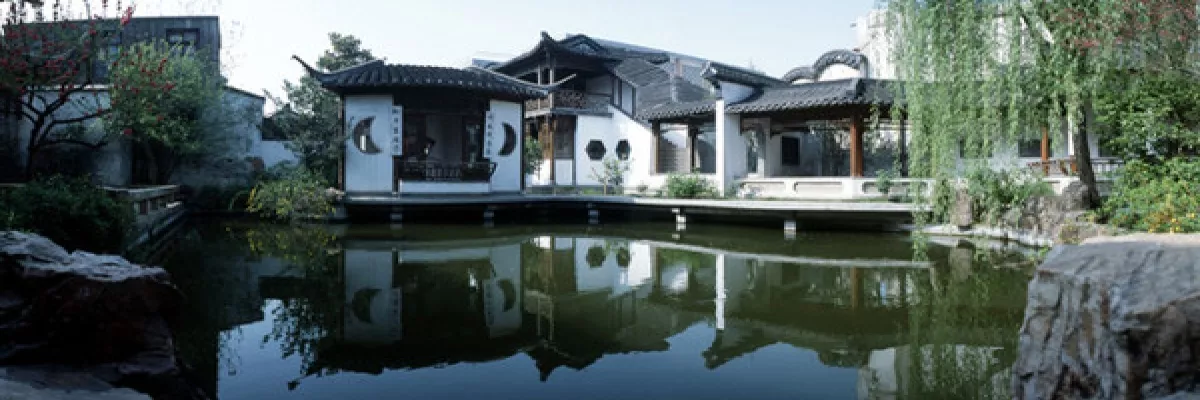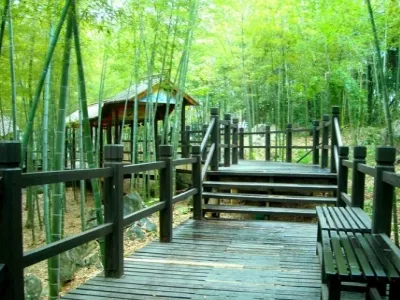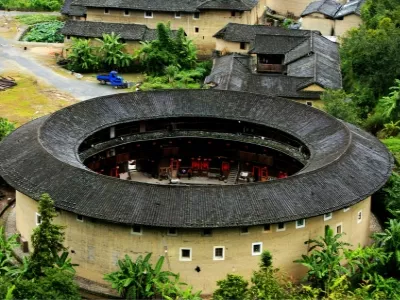Yangzhou is best seen in sunny breezes, soft moonlight, and misty rain when her grace emerges. This tranquil city in southern Jiangsu charms even on foot without tiring treks. Gone are the ostentatious days of "tying tens of thousands in waist sashes and riding cranes to Yangzhou”. Past too are the flashy times to “win thin fame at Green Houses after Yangzhou dreams decade-long sleeps”.
Guangling District is the old city heart with top sights concentrated. Shuangdong Historic Area along Dongguan Street and East Circle Gate Lane exude vintage Yangzhou appeal. Taste signature snacks and shop time-honored stores in this atmospheric neighborhood.
Trading grandeur for tranquility, Yangzhou now captivates through harmonious pacing in heritage sites and scenes. Meandering at one's own speed reveals the city's gentle beauty. Here, leisurely wandering leads to profound discovery.
In the morning, there is water on the foreskin, and in the evening, there is water on the foreskin
Yangzhou is famed for its "three knives" - the razor, cleaver, and foot-paring knife. And the essence of slow living here means starting your day with tea and ending it with a soothing soak. For breakfast, try the city's famed "pouch water" - xiaolongbao soup dumplings - at venerable teahouses like Fuchun, Yechun, Gonghechun, and Jinchun. In the evening, wash the day away at a historic bathhouse like Yangzhou Bathhouse, Yongning Hot Springs, or Shuanggui Hot Springs. They offer the full spa treatment from head to toe. Newcomers Lute Foot Massage and Su Yang Foot Care build on the city's pedigree in the pampering foot care department. Morning tea, evening baths - this is the rhythm of Yangzhou. So embrace the laidback local lifestyle. Begin your day with a steaming basket of dumplings and aromatic tea. Then end it with a relaxing foot soak and massage as you decompress from your explorations.
The Story of Old Yangzhou in Shuangdong District
Stepping into the Shuangdong Historic District is like entering a time portal to over 100 years ago. With its unadorned gray brick walls and winding alleys, time moves slowly here. Elders play chess at stone tables while children read under twisted tree shadows. This less than one square kilometer area packs in 108 interconnected lanes lined with venerable shops, houses, and a legacy of living heritage. As you explore the compact labyrinth of alleys, stories from old Yangzhou come to life. Peek into a century-old herbal medicine shop, its shelves still lined with wooden drawers of mysterious ingredients. Listen to the clacking of a loom in a family-run textile workshop. Smell enticing street snacks sizzling on a corner griddle. Let the handicrafts, calligraphy, and age-old traditions transport you back through the generations who once walked these lanes. At Shuangdong, the echoes of history, family, and community endure. Lose yourself in Old Yangzhou's enduring narrative, one delightful detour at a time.
Best Travel Time
The so-called "fireworks come to Yangzhou in March" is perfect for spring (April May). At this time, Yangzhou city has clear winds, drizzle, slanting willows, and Qionghua, making it the most beautiful time of the year and the least suitable season. Summer (July and August) is the hottest season in Yangzhou. Image: Best travel time.History
Archaeological evidence confirms human activity in Lianyungang's ancient Mount Qushan and present-day Mount Jinping area as early as 10,000 years ago. In 1959 and 1978, the oldest Paleolithic sites in southeast China were discovered at Erjian and Daxian Village with clear stratigraphic layers. Mount Jinping has 19 Neolithic sites, with Erjian being one of China's earliest farming areas.
The 20-meter long, 10-meter wide "General Cliff Painting" discovered in 1979 was appraised by the State Administration of Cultural Heritage as "an extremely important cultural relic and rare major discovery, the earliest 'book' in China."
The Donghan era art treasure "Kongwang Mountain Grottoes Statues" are the earliest Buddhist grotto statues in China, 100-200 years earlier than the Dunhuang Grottoes, and protected at the national level.
The area is also steeped in history, with attractions related to Confucius' sea gazing, Emperor Qin's inspections, and famous poets and officials like Tao Yuanming, Li Bai, Su Dongpo, Shen Kuo, Li Qingzhao, Wu Cheng'en, Li Ruzhen, Wu Jingzi, Lin Zexu, Zhu Ziqing and more.
Self driving
Driving to Yangzhou from Shanghai:
Take the Shanghai-Nanjing Expressway, then enter the Yangli Expressway towards Runyang Bridge. This brings you directly to Yangzhou. Note the Yangli Expressway has both "Yangzhou West" and "Yangzhou North" exits - Yangzhou North is closer to Slender West Lake scenic area, while Yangzhou West is closer to the bus station.
Alternatively from Shanghai, take the Shanghai-Nanjing Expressway to Zhenjiang, cross Runyang Bridge, then take the Nanjing-Tongling Expressway to the "Yangzhou South" exit.
Or from Shanghai, take the Beijing-Shanghai Expressway past Wuxi, transfer to the Nanjing-Tongling Expressway at the Yangzhou exit, cross Jiangdu Bridge toll station, then take "Yangzhou East" exit into the city.
From Beijing:
Take the Beijing-Shanghai Expressway south through Tianjin, Jinan, Huai'an and onto the Yangzhou exit. Cross Jiangdu Bridge toll station, transfer to Nanjing-Tongling Expressway and take "Yangzhou East" exit.
From Nanjing:
Take the Nanjing-Tongling Expressway from Nanjing Second Bridge, exiting at "Yangzhou South".
With mostly expressways, Yangzhou is an easy drive from surrounding cities via the major expressway network. Follow the directions for the most convenient route.
Medical treatment
Here is a suggested paragraph about safety tips in Changhua, Taiwan for an English travel website:Staying Safe in Changhua, TaiwanChanghua is generally very safe, but you should take some basic precautions. Keep valuables secured and be alert in public areas to prevent petty theft. A special note for Southern Taiwan including Kaohsiung, Tainan, and Kenting - avoid discussing politics as tensions can run high in this region. However, southerners are usually still very warm and friendly, even towards mainland Chinese tourists.Use common sense, take care of belongings, and avoid political conversations in the south. Following basic safety measures will allow you to fully enjoy your travels in Changhua and the rest of Taiwan.Tourism consulting
When at crowded places like train stations, bus terminals, and metro stations, keep a close eye on your belongings to prevent theft. Areas with high tourist traffic like Tiananmen Square also attract scammers, so tourists should be wary of unlicensed guides demanding money upfront. Avoid handing over any cash to solicitations on the street. Use registered taxi companies like the red Beijing taxis whenever possible. Keep valuables secured and hidden, avoid carrying large amounts of cash, and be alert in public transportation hubs and tourist sites. When needing assistance, go to authorized help points like the Beijing Tourist Information booths rather than individuals roaming the streets. Beijing is a generally safe city if simple precautions are taken. Report any incidents or suspicious activities immediately to the nearest police officer. They can also provide directions and other help. Enjoy sightseeing, but remain aware of the surroundings.















